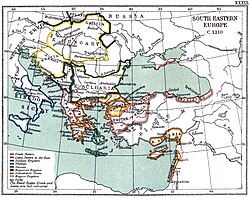Battle of Antioch on the Meander
| Battle of Antioch on the Meander | |||||||
|---|---|---|---|---|---|---|---|
| Part of the Byzantine-Seljuk Wars | |||||||
 Map of southeastern Europe and Asia Minor, showing the Nicaean Empire and Seljuk Sultanate ca. 1210. |
|||||||
|
|||||||
| Belligerents | |||||||
| Empire of Nicaea | Seljuk Sultanate of Rûm | ||||||
| Commanders and leaders | |||||||
| Theodore I Laskaris |
Kaykhusraw I † Alexios III Angelos (POW) |
||||||
| Strength | |||||||
| 2,000 men 2,000 cavalry (800 Latin mercenaries and the rest Byzantine) |
5,000 - 11,000 | ||||||
| Casualties and losses | |||||||
| Heavy Most of the Latins died. |
Heavy | ||||||
The Battle of Antioch on the Meander (also known as the Battle of Alaşehir) was a military engagement near Antioch-on-the-Meander between the forces of the Empire of Nicaea and the Seljuk Sultanate of Rûm. The Turkish defeat ensured continued Nicaean hegemony of the Aegean coast of Asia Minor. The Seljuk sultan, Kaykhusraw I, was killed on the field of battle. The battle took place near the modern town of Yamalak in Kuyucak district in Aydın Province.
Following the capture of Constantinople by the forces of the Fourth Crusade (1204) and the partition of the Byzantine Empire, Theodore Laskaris (r. 1205–1222), crowned emperor in 1208, built up a power base in the former Byzantine territory of western Anatolia. This new polity was to become known as the Empire of Nicaea. Nicaea was one of the two main Greek successor states that claimed the heritage of the Byzantine Empire, along with Epirus in western Greece. Nicaea was threatened from the north by the new Latin Empire established by the Crusaders, and from the east by the Seljuk Sultanate of Rum.
The peace with the Seljuks was disturbed through the arrival, in early 1211, of the former Byzantine Emperor Alexios III (r. 1195–1203), at the port of Attaleia. The subsequent events are described in some detail by a number of near-contemporary sources, chiefly the chroniclers Ibn al-Athir and Ibn Bibi on the Seljuk side and the histories of George Akropolites and Nikephoros Gregoras on the Byzantine side, as well as references in other chronicles and the orations in honour of Theodore Laskaris by Niketas Choniates.
...
Wikipedia
